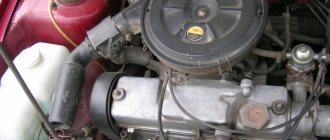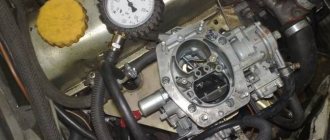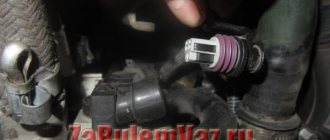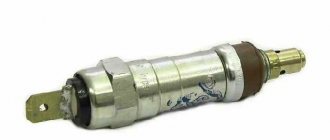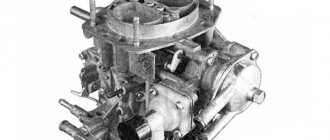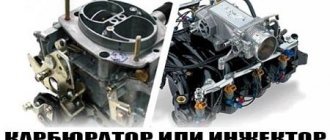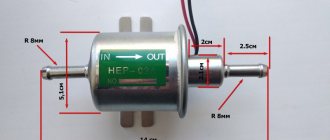The fuel system of a car consists of various components and parts that can perform similar functions. For the engine to operate, a fuel supply system is needed, and the solution to such problems is to install a carburetor or injector. Although these devices have fundamental differences in design, their task is to prepare a combustible mixture. Depending on the car model, one of these systems is installed, and it is quite simple to find out the difference between an injector and a carburetor.
Carburetor design
Carburetor - is the simplest type of device for supplying and spraying gasoline. The process of mixing fuel with air is performed mechanically, and adjusting the supply of the mixture requires careful adjustment. Thanks to the use of simple mechanisms, the carburetor system is easy to maintain. An experienced motorist can perform such repairs independently, which provides certain advantages in operation. For such operations, it is not difficult to purchase a repair kit, and all work is carried out with standard tools available in the car.
The carburetor is located on the intake manifold, and its design consists of a float and mixing chambers. To supply fuel, a spray tube is used, connecting the chambers to each other. Fuel is supplied to the float chamber using a gasoline pump, and a stable supply of gasoline is ensured by a needle filter and a float. The mixing chamber is also called the air chamber and consists of a diffuser, atomizer and throttle valve. When the pistons move, a vacuum is created, which ensures the suction of atmospheric air and gasoline. This mixing ensures stable engine operation.
Comparison of fuel supply systems
To briefly summarize, the difference between a carburetor and an injector is as follows:
- The first allows the engine to suck in the combustible mixture through a system of calibrated holes, the second forcibly supplies fuel to the cylinders through injectors.
- The carburetor control is completely mechanical. Only on the latest modifications did solenoid valves appear, operating from primitive forced idle controllers (FIC). The injection fuel supply is completely controlled by electronics.
- The injector is a fuel rail with nozzles, the number of which is equal to the number of cylinders. A carburetor is a complex mechanical unit consisting of many small parts.
- Injector nozzles are located in close proximity to the combustion chambers or are built into them. The carburetor is bolted to a common manifold that distributes the mixture among the cylinders.
- Gasoline for carburetion is supplied by a pump driven by the crankshaft drive. The injector ramp receives fuel from an electric fuel pump immersed in the tank.
Reference. The injector principle has long been implemented in diesel engines. Sprayers deliver clean diesel fuel directly into the cylinders during the compression stroke.
Despite the complexity of the design and the abundance of small elements, the carburetor is easier to maintain with your own hands. A car enthusiast can independently disassemble the unit, clean the jets, replace the membranes, or adjust the gasoline level in the float chamber.
It’s not so easy with an injector - finding problems with the electronic circuit or sensors is much more difficult. But the reliability of the system plays a role here - the carburetor requires maintenance once every 20 thousand km, and it is advisable to clean the injectors at intervals of 40–50 thousand km. The service life of the sensors is at least 50 thousand km, during which time the carburetor will have to be disassembled twice. Please note that during operation the jets often become clogged and the diaphragms become unusable.
In terms of performance characteristics, the injector also wins and here's why:
- thanks to forced injection, cold engine starting is easier;
- for the same reason, it is easier to start a worn engine with reduced compression, which is not able to draw fuel from the carburetor;
- electronics ensure a more accurate dosage and ratio of gasoline to air in the mixture, and this increases engine power and reduces fuel consumption.
For these reasons, drivers of cars equipped with an injector will never go back to a carburetor, and the younger generation does not know about it at all. The outdated fuel supply method is retained only on some sports cars and domestic cars with high mileage.
Injector device
Injector - has a more advanced fuel supply control system. All operations are monitored by an electronic system. Such equipment calculates with high accuracy the portion of fuel required for engine operation. To determine the required flow rate, readings are taken from many vehicle sensors, and the microcontroller instantly makes the necessary calculation. To understand which is better, a carburetor or an injector, it is worth comparing their design and giving preference to a more practical model.
Fuel is supplied to the injector using special nozzles. This principle of operation differs from carburetor injection, and almost all modern cars are equipped with it. Fuel injection into the air flow is automatic and depends on the engine operating mode. The nozzle itself opens due to the action of an electromagnet, and closes using a spring. In such a system, constant pressure is maintained by a special valve on the ramp, which discharges excess fuel.
Depending on the make of the car and the characteristics of the engine, the following injector connection options can be used:
- Single-point (mono-injection);
- Multipoint (distributed);
- Direct (direct injection).
Such a system requires precise injection control and depends on the quality of the fuel. For such purposes, the injector uses an electronic control unit that coordinates the supply of gasoline with driving conditions.
Features of the injection system
The main difference between injectors, or more precisely, fuel injection systems, is the supply of gasoline under pressure.
The role of the fuel pump is no longer limited to filling the float chamber, as it was in the carburetor, but has become the basis for dosing the amount of gasoline supplied through the injectors into the intake manifold or even directly into the combustion chambers.
There are mechanical, electronic and mixed injection systems, but they have the same principle - the amount of fuel per operating cycle is calculated and strictly measured, that is, there is no direct connection between the air flow speed and the cyclic gasoline consumption.
Nowadays, exclusively electronic injection systems are used, where all calculations are carried out by a microcomputer that has several sensors and continuously regulates the injection time. The pump pressure is maintained stable, so the composition of the mixture clearly depends on the opening time of the injector solenoid valves.
Fundamental differences between a carburetor and an injector
The carburetor's job is to prepare and supply the air-fuel mixture necessary for engine operation. Moreover, such a mixture is supplied regardless of the engine operating mode. This fuel supply system is characterized by high consumption and severe atmospheric pollution by exhaust gases.
You can determine the difference between an injector and a carburetor by studying their operating principle and the main differences. The engine, equipped with an injector, receives fuel in a precisely calculated dosage, eliminating overconsumption. The use of such technology has not only an economic effect. The power of an engine operating under the control of an injector increases by an average of 10%. The vehicle's driving dynamics also improve, which has a positive effect on its handling.
Searching for a compromise option
When deciding whether an injector or a carburetor is better for a motorist, it is necessary to take into account the statistics of passenger cars produced in the world. The trend in the production of carburetor cars is characterized by a decrease, in contrast to the growing trend of the competitor.
One of the main factors is the degree of environmental friendliness of transport, which they are trying to stimulate by raising standards for cars produced in Europe or on other continents. As a result, exhaust gases are cleaner with an injection design. Systems with carburetors have a much more difficult time maintaining high emissions standards.
Knowing the design of both systems helps to understand which engine is optimal in all respects. The earlier one is carburetor. Its name comes from the French word Carburation (mixing). The mixture is prepared directly inside a separate installation, where air and fuel are supplied in a certain dosage. The pre-formed mixture is sucked through the manifold due to the pressure difference.
Advantages of a carburetor
The carburetor fuel supply system has undergone decades of testing and has the right to count on the attention of drivers. Its main advantage is the ability to repair it in almost any unforeseen situation far from a service center. The advantages and differences of this technology are easy to see from the following indicators:
- Lower cost of the device and its operating costs;
- Lack of carbon deposits and relative undemanding requirements for fuel;
- Easy to repair and low cost of services;
- Using the engine to suck in fuel.
The carburetor is sensitive to temperature conditions. Extreme heat or freezing temperatures can make it difficult to start the engine. It is worth noting that the carburetor is considered an outdated technology and does not meet EURO 3 requirements.
Alteration of the type of fuel mixture supply
To improve a car operated in urban conditions, conversion to an injector is most suitable. The car owner will have to modify, purchase many parts and kits to achieve the result. At the preparation stage, you should have all the necessary spare parts, disassemble the front part of the car for convenient work.
Draining liquids, disassembling the carburetor, the future injection system and the fuel line are the basis for starting work; it is necessary to check the differences between the units. The VAZ power supply system is changed to an identical injection line; the cylinder head and intake manifold are replaced in most cases.
Carrying out a replacement requires certain skills, a determination of whether a carburetor or an injector is better for the car owner, as well as an approach to work. If you do not have enough experience, tools and training, you should contact specialists at a qualified car service center.
If you have any questions, watch this video, the answer to the question of what is better is a carburetor or an injector:
Injector advantages
Modern electronic fuel delivery systems are superior to carburetors in many ways. In this case, stable engine operation extends the life of the equipment and makes repairs rare. A significant difference between a carburetor and an injector can be seen in the advantages of the electronic system.
- Optimal fuel composition for any engine mode;
- High reliability of the automatic injection system;
- Better handling when speed increases;
- Insensitivity to negative temperatures;
- Advantages in power and moderate fuel consumption.
The injector has proven itself in various operating conditions. Such equipment is sensitive to the quality of fuel and questionable gas stations should be avoided. Repairing an injector is expensive, but given its service life and reliability, this system is preferable to a carburetor.
Historical excursion
The first liquid carburetor operating on the principle of evaporation was created in 1872, according to other sources - in 1876. And 20 years later (1893), the Italian Donat Banki developed a device based on the spraying of gasoline. Gradually improving and acquiring various systems, it existed on automobile engines for almost a century.
The injector's pedigree dates back to the same times. As early as 1902, the engines of the French engineer and racing driver Levasseur contained some elements of mechanical fuel injection.
The idea was borrowed by aviation designers interested in the fact that the operation of the injector does not depend on gravity. By the end of the Second World War, injection engines appeared on some aircraft of the warring parties, including the USSR.
The Mercedes-Benz 300SL (“Seagull Wing”) received mechanical forced injection for the first time on a production car in 1954. And electronically controlled fuel injection was tested by the Italians even before the war.
Since the 80s of the last century, injection gasoline engines have become widespread due to the advent of affordable electronic components for creating electronic engine control systems . Carburetor engines are practically never found on modern cars, except for some racing cars.
Selecting the optimal fuel supply system
Thinking about the difference between an injector and a carburetor, many motorists come to the conclusion that the electronic system is much more reliable. However, re-equipping any car is not economically profitable and will only lead to unnecessary costs. The decision to choose a more economical system is important when buying a car. It’s quite easy to understand the difference between an injector and a carburetor, and such knowledge will definitely come in handy.
The carburetor has already served its useful life in the modern car market. Despite its advantages, the use of an injector is most effective and meets all environmental requirements. Carburetor engines are used mainly on older cars, but this technology has proven itself and does not need modification. The use of an injector has considerable advantages and this system is installed without choice in any new car.
If you have any questions, leave them in the comments below the article. We or our visitors will be happy to answer them
How to distinguish an injection car from a carburetor
If you know what a carburetor looks like, then all you have to do is open the hood and look under it. But if you have no idea about it, then a number of signs will help you identify it:
- a new car sold at a car dealership is 100% fuel-injected;
- look at the nameplate at the rear of the car - for example, it says BMW 525i. This “i” is the designation of an injection car;
- year of car manufacture. Injectors began to be installed on foreign cars in the mid-90s, on domestic ones - from the beginning of the 2000s;
- The air filter housing is mounted directly on the carburetor. If you see air ducts (for example, black plastic corrugated boxes), then most likely you have an injection machine in front of you;
- If the indicators that light up on the dashboard when you turn the key contain a “Check Engine” indicator, then the car in front of you is fuel-injected.
The principle of operation of a carburetor engine
In order to create conditions for combustion in the cylinder, gasoline must be mixed with air. The atmosphere contains oxygen, which is necessary for the oxidation of gasoline hydrocarbons, releasing a large amount of heat.
Hot gases have a significantly larger volume than the original mixture, and by seeking to expand, they increase the pressure on the piston, which pushes the crankshaft and causes it to rotate. Thus, the chemical energy of the fuel is converted into mechanical energy, which drives the car.
A carburetor is needed to finely atomize gasoline and mix it with the air entering the cylinder. At the same time, the composition is dosed, since for normal ignition and combustion a fairly strict mass composition is needed.
To do this, in addition to the nozzles themselves, carburetors have several metering systems, each of which is responsible for a specific engine operating mode:
- main dosing;
- idle system;
- a starting device that enriches the mixture on a cold engine;
- accelerator pump that adds gasoline during acceleration;
- econostat for power modes;
- level regulator with float chamber;
- transition systems of multi-chamber carburetors;
- various economizers that regulate and limit harmful emissions.
The more complex the carburetor, the more of these systems it contains; usually they are hydraulically or pneumatically controlled, although in recent years of development electronic devices have begun to be used.
But the basic principle remains the same - the fuel emulsion, formed by the joint work of the air and fuel nozzles, is drawn into the flow of air sucked in by the pistons through the nozzles in accordance with Bernoulli's law.
Differences between the two types of engines
What is the difference between an injection engine and a carburetor engine? The two types of gasoline internal combustion engines (ICEs) differ from each other both in the method of power supply and in the composition of the incoming components. An injection and carburetor engine are “two big differences,” as they said in Odessa.
The main thing that characterizes each system is the technology of mixture formation and, accordingly, the technical solution. The table shows the most important fundamental and design differences.

